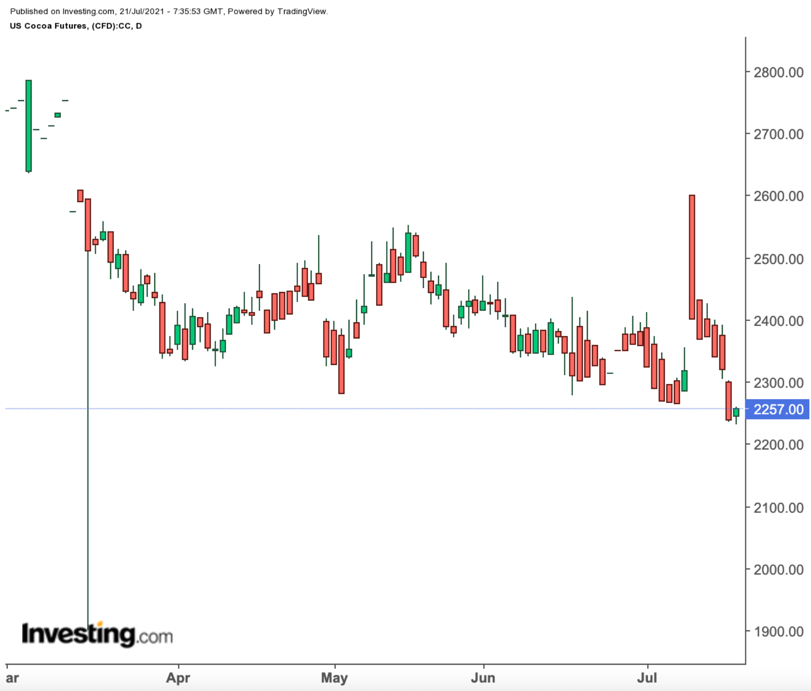Cocoa grinders from the United States to Europe upped their processing of the commodity in the second quarter as confectioners sought more of the raw material for turning out chocolates, baked goods, ice cream and other delicious treats. 
But such demand isn’t likely to help the bear market for cocoa, not with COVID making a comeback via the Delta variant.
Cocoa futures traded on ICE settled at $2,254 a tonne on Tuesday. While that marked a 0.7% rise from the previous session, the price was actually lower than the $2,373 settlement of July 14, which was a day before the release of North American cocoa grinds data that typically moves the market.
The National Confectioners Association, which gathers grind data for the United States, Canada and Mexico, reported on July 15 that 123,719 metric tonnes of cocoa were processed in the second quarter, up 12% from the 110,776 tonnes in the comparative January-March 2020 period.
European Cocoa Association data showed that EU confectioners handled 356,854 tonnes, or 14% more than the 314,108 tonnes ground in the year-ago quarter.
Grinds produce the cocoa butter that gives chocolates and ice cream their smooth, velvety taste. It also turns out the powder needed for making cakes, cookies and chocolate beverages.
No Escaping This Bear Market
Despite the bullish demand from industry, cocoa prices haven’t been able to escape the bear market they’ve been trapped in. Since hitting a February high of $2,998 on ICE, it has been in a steady slide, losing almost 25%.
On the LIFFE exchange, three-month cocoa traded in London has also tumbled from a February peak of $1,979 to $1,559 at Tuesday’s close, losing 21%.
Market terminology stipulates that any security that loses 20% or more of its value from a recent high is technically in a bear market.
The reason for cocoa’s malaise is obvious: The global pandemic is making a return via the highly transmissible Delta variant.
Jack Scoville, chief crop analyst at Chicago’s Price Futures Group, added:
“The daily charts show short term mixed trends in New York and in London and the fundamentals remain bearish despite the increased demand.”
“The return of COVID around the world hurt demand ideas as world economies could suffer again.”
Chocolate is a luxury product that aside from Valentine's Day, sees peak sales during Halloween and year-end festivities. Also, confectioners do the bulk of their sales through stores instead of online.
Both these peculiarities make cocoa vulnerable as COVID cases surged in recent weeks, prompting some countries, including Australia and South Korea, to reintroduce restrictive measures. The UK on Saturday reported the highest number of daily COVID-19 cases since January 2021.
Threat of Lockdowns Loom Again
If lockdowns and other curbs became a regular feature in the second half of the year, that would not be too good for a luxury or festive product.
Supply of raw cocoa beans out of West Africa, the main production region for the commodity, was also plentiful, said Scoville.
“Ports in West Africa are filled with Cocoa right now,” he added. “The weather has had above average rains in West Africa and crop conditions are rated good.”
From a technical perspective as well, cocoa prices may have more to lose.
Investing.com’s Daily Technical Outlook for ICE cocoa futures has the market trading as low as $2,192 to $2,148 per tonne at the lowest end of near-term support. That’s another drop of 3%-5%.
Disclaimer: Barani Krishnan uses a range of views outside his own to bring diversity to his analysis of any market. For neutrality, he sometimes presents contrarian views and market variables. He does not hold a position in the commodities and securities he writes about.
